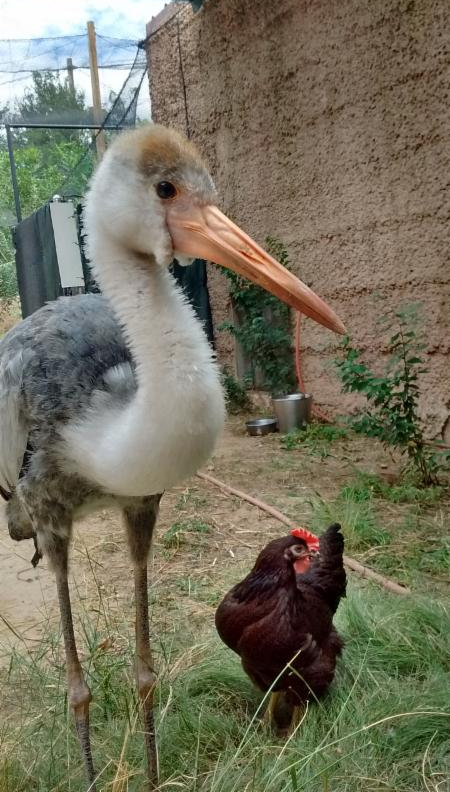
Fowl Friends
Why is an African crane species being bred at the ABQ BioPark? And why is she such good friends with a domestic hen?
By Dylan Frentzal, Zookeeper II
Why did the chicken cross the road? Perhaps the answer is to be with her best friend, the wattled crane. A better question is why is an African crane species being bred at the ABQ BioPark? And why is she such good friends with a domestic hen?
The wattled crane is a 6-foot-tall species that once ranged from the Horn of Africa to its western coast and down to the southern tip of the continent. Their range is now drastically reduced and they are found only on the Okavango Delta. The wattled crane is Africa's most wetland-dependent crane, as wetlands are critical for the species' feeding and reproduction.
Unfortunately, these wetlands also are being lost and degraded because of upstream river regulation and intensified agriculture. These elegant birds had an estimated wild population of 7,700 in 2007, but it is likely that even less of them survive today as the population is considered to be declining. Only 116 are currently found in zoos worldwide.
In spring 2015 the ABQ BioPark's pair of Wattled Cranes laid an egg, which was collected and placed in an incubator because of the parents' lax attitude toward it. Inexperienced parents can sometimes take several seasons to figure things out, so the egg was pulled to protect it. That egg produced one of only three wattled crane chicks hatched in captivity in North America last year.
Senior Bird Keeper Diane Longnecker helped the chick hatch as it struggled to free itself. Right away, Longnecker knew this bird would benefit from some company. Wattled cranes can imprint on people, so human interaction needed to be limited. Longnecker purchased a domestic chick so that the crane chick would have a companion to show it how to eat, but the chicken needed to be kept separate at first, behind a wire barrier, to ensure its safety.
As the two grew older they were gradually introduced. Bird Keeper Amanda Baca spent hours observing their interactions until it was determined that the two could be left together unsupervised. Now, they spend all their time together and are never seen apart.
The unlikely crane-chicken pair is currently housed behind the wattled crane biological parents, which are on exhibit near hyenas and cheetahs. The parents have been demonstrating courtship dancing behaviors again this year, and have started building nest piles. The bird department is expecting this pair to lay another egg soon.
Bird Supervisor Keith Crow says the goal this year is for these birds to incubate and raise a chick entirely on their own. While the bird department does not mind lending a helping hand, it will be better for the chick if the parents are prepared to raise it.
Between now and March is a good time to peek in on the African bird exhibits, as wattled cranes and Cape Griffon vultures will likely both be sitting on eggs. With some luck, another wattled crane chick will hatch this spring and its parents will keep it their company, not that of another chicken.

